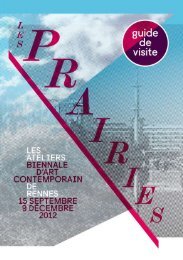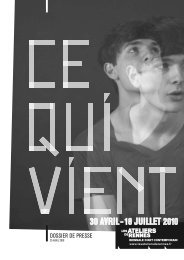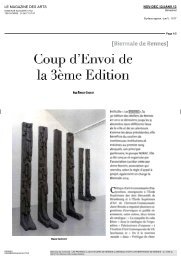Download here the Visitor's guide. - Les Ateliers de Rennes
Download here the Visitor's guide. - Les Ateliers de Rennes
Download here the Visitor's guide. - Les Ateliers de Rennes
You also want an ePaper? Increase the reach of your titles
YUMPU automatically turns print PDFs into web optimized ePapers that Google loves.
MANFRED PERNICE<br />
Tiefengarage, 2008. installation view, Culturgest, Lisbonne.<br />
Courtesy of <strong>the</strong> artist and galery Neu, Berlin. Photography : DMF, 2008.<br />
<strong>Les</strong> Prairies's artists<br />
Manfred Pernice's installation-like<br />
sculptures call to mind pieces of<br />
domestic or urban furniture. His<br />
architectonic sculptures use cheap<br />
materials such as cardboard,<br />
plywood, chipboard, or concrete.<br />
Certain aspects are <strong>de</strong>signed to<br />
emphasise <strong>the</strong>ir mo<strong>de</strong>st, even dull<br />
finish – <strong>the</strong> persistence <strong>here</strong> of an<br />
aes<strong>the</strong>tic, created in retrospect, in<br />
East Germany. In 2008 he created<br />
his installation Tiefengarage for<br />
<strong>the</strong> spaces of <strong>the</strong> Lisbon Culturgest.<br />
The German title was invented by<br />
Pernice. The adjective tief affixed<br />
to <strong>the</strong> word garage is inten<strong>de</strong>d<br />
to evoke <strong>the</strong> psychoanalytical<br />
notion of Tiefenpsychologie (<strong>de</strong>pth<br />
psychology). The Tiefengarage is<br />
painted grey to half-way up and<br />
filled with woo<strong>de</strong>n benches and<br />
stools, objects and photographs<br />
and is strongly suggestive of <strong>the</strong><br />
aes<strong>the</strong>tics of un<strong>de</strong>rground places<br />
reserved for things not being<br />
used – car park, garage, or cellar.<br />
Psychology is not missing from<br />
this space; its inaccessibility might<br />
symbolise a buried or repressed<br />
subconscious. The frames on <strong>the</strong><br />
wall enclose images that are<br />
discernible in spite of <strong>the</strong> weak<br />
light. They are reproductions of<br />
illustrations and photographs from<br />
<strong>the</strong> archives of a Czechoslovakian<br />
art stu<strong>de</strong>nt in West Berlin in <strong>the</strong><br />
1960s. This uniformly black and<br />
white iconographic assembly<br />
translates <strong>the</strong> weaving toge<strong>the</strong>r<br />
of a collective and an individual<br />
subconscious.<br />
H. M. tr. J. H.<br />
Born in 1963 in Hil<strong>de</strong>sheim<br />
(Germany), lives and works in Berlin<br />
(Germany).<br />
retrouvez cet artiste au Musée <strong>de</strong>s beaux-arts <strong>de</strong> <strong>Rennes</strong><br />
65






